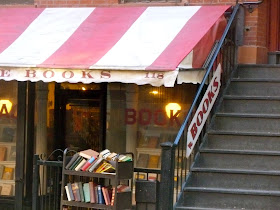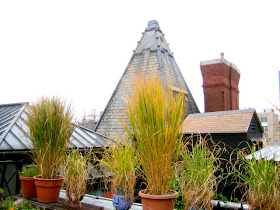Mark Schulte has been a lease-holding tenant at the
Elk Hotel for the past 5 years, moving in permanently after 15 years of being a transient guest at the 87-year-old flophouse off Times Square.
On February 7, he tells me, he and the rest of the Elk's tenants arrived home to find new staff working the front desk and two days' notice to vacate the premises. Without warning,
the building had been sold in a purchase that nearly completes the acquisition of an entire block of tenements along 9th Avenue between 41st and 42nd Streets.
 all photos: my Flickr
all photos: my Flickr
As Mark walks me down the Elk's murky hallways, I step carefully across checkerboard linoleum floors so mushy it feels like my feet will break right through. Here and there, we pass over the litter of syringe wrappers, cigarette butts, and beer bottles. We peer into abandoned rooms, miserable warrens of cracked walls and moldy ceilings, some just big enough for nothing more than a twin-sized mattress. In one room, a dead mouse swells on the carpet.
 "The new landlord picked off the low-hanging fruit," Mark says, by offering small buyouts of $2,000, then $5,000
"The new landlord picked off the low-hanging fruit," Mark says, by offering small buyouts of $2,000, then $5,000. The drug addicts and many of the elderly took the cash and left. About a dozen lease-holding tenants remain.
One who might have taken the buyout, but didn't get the chance, was a woman whose body was found by Mark and a neighbor on February 10 in Room 211. It had been decomposing in bed for two weeks. As we stand in front of the NYPD-sealed door, the smell of human decay is still pungent.
"I wasn't sure what I was looking at," Mark says, "It was not recognizable as a body." It looked like a pile of blackened rags with a hot-pink wig lying on top of it. A friend down the hall who just happens to work as an embalmer identified the body as a well-known tenant who had recently dyed her hair pink. She used to sit outside Port Authority and panhandle with a sign that said "Times have been tough." This is how the woman paid her $180 monthly rent at the Elk.
 Another tenant, called "Pops," isn't budging
Another tenant, called "Pops," isn't budging. An 85-year-old war veteran, Pops can only hobble from his room to the shared bathroom and back. He can't walk down the stairs, so he sends his neighbors out for coffee and sandwiches. His window looks out on the well-known Pepsi sign--his view for many years.
Then there's the tenant that Mark and his neighbors "affectionately refer to as Coo-Coo." Suffering from some unknown mental illness,
Coo-Coo roams the halls in dirty underwear, picking through the garbage to take items back to his room--empty tuna cans are a favorite--where he hoards them in a kind of nest. He begs the neighbors for cigarettes, and carries a thick bankroll of Guyanese dollars--worth almost nothing. Coo-Coo's response to the buyout is: "I'm staying."

While the Elk was known for being a holdout of Times Square seediness, with rooms on the first floor renting by the hour and filled with the dramatic moaning of prostitutes,
most of the permanent residents who remain are like Mark--"average guys," he says, who found themselves couch-surfing on one couch too many, and discovered cheap rent and privacy at the Elk Hotel. They make their living as cooks, musicians, performers.
Retired, Mark spends his time writing and doing volunteer work, mostly for LGBT causes. He's a veteran of ACT UP and Queer Nation, he says, "So I'm not afraid of getting in people's faces." He has a lawyer and is fighting for his rights, as life at the Elk has deteriorated fast in the past few weeks.

"On Saturday, February 11 at 8:30 A.M.," Mark tells me, "a demolition crew came in, removed all the doors from vacant rooms, and carried out everything but the sinks." On the night of February 13, with about a dozen holdouts remaining after the buyout deadline, "
the heat and hot water was turned off... We spent a very cold night," says Mark. The next day, the tenants went to court and got their heat back.
"Now we're just waiting to see what the landlord's next move will be," Mark tells me. "I'm going to ride this out. They're probably going to demolish the building and I'm willing to leave, but I need more than $5,000. That's not even enough for a deposit with first and last month's rent someplace."
And
what will happen to Pops and Coo-Coo, he wonders, and to other tenants like them who cannot advocate for themselves and have even fewer resources? $5,000 won't help them find and keep a new home. It will, however, pay
one month's rent on a two-bedroom at the Elk's high-end new neighbor, the Orion.

A 58-story glass shaft of luxury condos and rentals, the Orion towers over the Elk. It also used the Elk's air rights, so nothing tall can be built on that corner. According to online records,
the Elk's new landlord now owns almost the entire block, from 568 - 578 9th Avenue, minus 572.
These buildings house a simple, but motley collection of first-floor businesses, like Dave's Tavern, the New Panda Chinese restaurant, a bodega, a barber shop, and Papaya Dog.
How long will this block remain standing?
 Orion--right next to the Elk's entrance
Orion--right next to the Elk's entrance
Over drinks at the
9th Avenue Saloon, Mark recalls his years at the Elk, remembering when the first-floor business belonged to LaFleur's, a transgender hustler bar run by locally famous drag queen
John LaFleur. That was the 1990s and the neighborhood was a much different place.
"But I knew this was coming," Mark says of the hotel's demise. "Because
it didn't make sense that the Elk was still there, being what it was. It used to be there were a number of hotels like the Elk. It's a way of life that's disappearing. You could come to New York with nothing, arrive on a bus at Port Authority, and get a cheap room around the corner, so at least you had a place to stay. And that's all vanishing."
"How do you think people without money come to New York today," I asked.
"They don't," Mark said.
 Mark looking up at Pops' window
See more:
Elk Hotel vanished
Elk Hotel
Mark looking up at Pops' window
See more:
Elk Hotel vanished
Elk Hotel
More photos inside the Elk on
my Flickr


















































